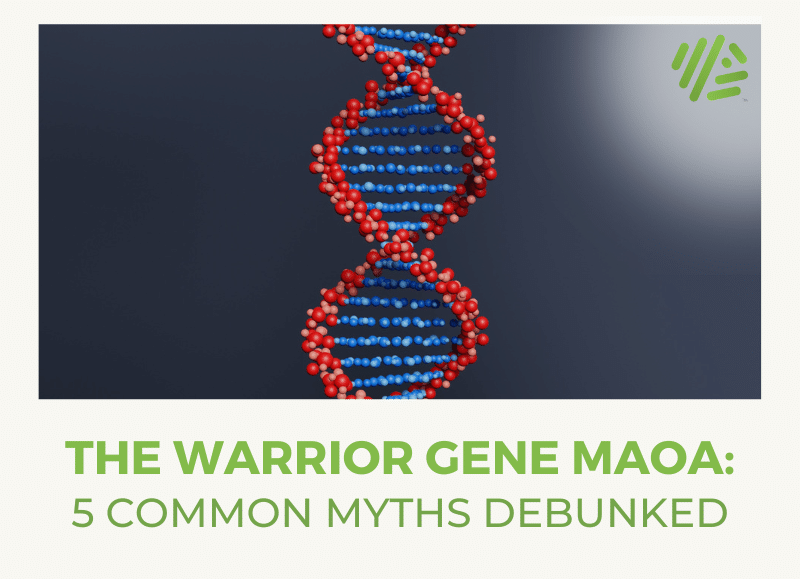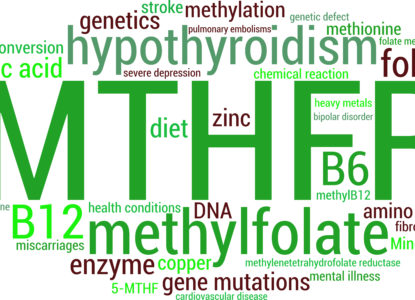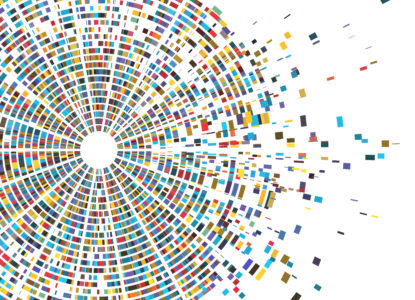The Warrior Gene MAOA: 5 Common Myths Debunked
Genes Mentioned

Contents
Much has been written about the so called “warrior gene” MAOA, also sometimes not as diplomatically referred to as the “Psycho” gene. 1
We all carry this gene, but certain mutations have been linked to an increased risk of violence, especially when there has been abuse in early life, which seems to act as the trigger that turns on the dormant predisposition to violence in some men. 2
First made famous by the story of a Dutch family with a history of violence, a court in Italy made headlines when it commuted the sentence of a violent criminal after it was found that he carried the variant of MAOA associated with aggression. 3
Monoamine oxidase (MAO-A) – the “Warrior Gene”
The MAOA gene codes for an enzyme named Monoamine oxidase. Monoamine oxidase breaks down neurotransmitters such as noradrenaline, adrenaline, serotonin and dopamine, and as such, plays an important role in regulating mood.
MAOA in men vs. women
Located on the X chromosome women can be heterozygous or homozygous for MAOA (as women have two X chromosomes), whereas men only carry one copy (as they have one X and one Y sex chromosome) and are therefore hemizygous.
The Genetics of MAOA
MAOA is interesting as changes in its activity don’t relate to individual SNPs, rather they are driven by changes in its promoter region.
All genes have a promoter region, which sit upstream in the DNA sequence and this is the location where polymerase proteins bind and begin to read through the gene.
- Within the promoter of MAOA is a region of DNA known as a variable number tandem repeat or VNTR.
- VNTRs are small sequences of DNA which can be repeated a variety of times, which gives rise to the 2R or 3R terminology you may have seen around MAOA. 2R means that there are two repeat sequences in the VNTR, 3R three repeat sequences and so on. This is important as the number of repeats has a big impact on how well MAOA is “read” by the polymerase protein.
- When the gene is not read as efficiently, not as much, MAO-A is produced, meaning the breakdown of neurotransmitters is also reduced. 4
- It is this lack of MAO-A enzyme activity which is thought to lead to increased aggressive behavior. 5
I’ve summarized the common repeats below and how they impact on the efficiency of MAOA reading and thus MAO-A activity. 3.5R and 4R variants are thought of as normal, with 2R variants having the most reduced function and 3R and 5R variants sitting between. As such the 2R, 3R and 5R types are sometimes referred to as MAOA-L meaning low activity. 6 7
| VNTR Number (R) | MAO-A Activity | Risk of aggressive behaviour |
|---|---|---|
| 2 | Reduced | Increased |
| 3 | Reduced | Increased |
| 3.5 | Normal | Normal |
| 4 | Normal | Normal |
| 5 | Reduced | Increased |
What effect do changes in MAOA VNTR have on aggression?
Low activity of MAO-A is thought to drive increased aggressiveness. But if you look at the table above you can see the 3R form of MAOA is actually very common. I don’t know about you, but upwards of 30% of the population being overly aggressive due to one gene sounds very high.
So let’s look at the data; the 2R, 3R and 5R variants which show reduced MAO-A enzyme activity have been linked with increased aggressiveness in a variety of studies. 10 11 So far the hypothesis seems to be holding together.
But! all these reports come with a very large caveat. Whilst they do show that the MAOA-L forms are associated with increased aggression, having an MAOA-L form does not mean that someone will be aggressive, there are numerous other factors associated, with the most important thought to be early life abuse. 12
Simply put, whilst some people with the 2R, 3R and 5R variants were more aggressive, there were lots of people who also had these variants who weren’t more aggressive. The associations only appeared when a large enough population was studied, and this suggests that there are lots of other factors which are also influencing how aggressive we are, not just MAOA. Some studies have failed to find a link between MAOA and aggression. 13
How to find out if you carry the warrior gene
The final important question is can you find out what form of MAOA you have using genetic tests like 23andMe? Well as mentioned above, alterations in MAOA function are to do with changes in the number of repeats in the VNTR, this can be detected by sequencing your genome.
23andMe doesn’t sequence your entire genome, rather they look at key points of interest in your genome. The reason for this is cost and time, whilst getting cheaper and faster all the time, the cost to sequence your entire genome is still out of the reach of most consumers. But, there are some things you can look at. Linkage disequilibrium is the complicated-sounding term that is used when two separate regions of the genome are associated with each other more or less often than would be expected by chance.
Say we’re interested in allele A; we know allele A is in linkage disequilibrium with allele B but we aren’t able to detect allele A. But if we were able to detect allele B we could then assume that allele A was also present. Interestingly there are several SNPS which are in linkage disequilibrium with the different forms of MAOA. I’ve detailed these in the table below, if you have the risk allele for one of the linked SNPs then you are likely to have the associated VNTR, but this is not definite, the only way to know for sure would be to directly analyze your MAOA gene.
So, for example those with the rs909525 ‘C’ allele are likely to have 3 repeats within the MAOA VNTR (3R).1415 Importantly, the proxy for 5R requires that you have all three of the risk alleles below rs909525 ‘C’, rs3027399 ‘G’ and rs6323 ‘T’. There currently isn’t a proxy SNP available for the 2R form although this is very rare.

Get Started With Personalized Nutrition
Gene Food uses a proprietary algorithm to divide people into one of twenty diet types based on genetics. We score for cholesterol and sterol hyperabsorption, MTHFR status, histamine clearance, carbohydrate tolerance, and more. Where do you fit?
Common myths about the Warrior Gene
Myth 1: The MAOA “warrior gene” is rare
Fact: We all carry the MAOA gene, just some of us have a form which may be linked with aggression. The alleles connected with aggression are carried by approximately 33% of the population, so if it’s just the MAOA genetic variant that makes us “warriors,” then there are lots of warriors running around out there. But trying to explain behaviour based on a single gene is a tricky business, as there are many other environmental and physiological factors that define who we are. So let’s have a look and see if the science stacks up, and see if we can bust some additional myths at the same time.
Myth 2: Men can be heterozygous for MAOA
Fact: Men only have one X chromosome, so can only have one copy of the MAOA gene
Myth 3: The aggressiveness associated with the “warrior gene” is caused by SNPs
Fact: Changes in MAOA function are actually linked to alterations in the VNTR located in the promoter region.
Myth 4: Having less active MAO-A will make you more aggressive

Fact: Having less active MAO-A may make you more aggressive, but there are many other factors that also influence this. It is very desirable to paint a simple picture, but understanding how genetics and behavior interact is very, very complicated, and unpicking the contribution of MAOA-L to increased aggression is very difficult, which I’ve summarised in the image below. Understanding the contribution of MAOA-L to increased aggression is difficult, as many other factors play important role. Whilst option a) may be most desirable to us as an easy to understand relationship b) is actually more accurate.
Myth 5: Consumer genotyping like 23andMe can tell me my MAOA status
Fact: There are some SNPs that associate with certain MAOA forms, but the only way to know for sure is to directly analyze MAOA.
| SNP ID | Major allele/Minor allele (Risk) | Risk allele "Warrior"? | % of population with risk allele |
|---|---|---|---|
| rs6323 | T/G | Y (5R*) | 67% |
| rs3027399 | G/C | Y (5R*) | 98% |
| rs909525 | T/C | Y (3R, 5R*) | 43% |

Get Started With Personalized Nutrition
Gene Food uses a proprietary algorithm to divide people into one of twenty diet types based on genetics. We score for cholesterol and sterol hyperabsorption, MTHFR status, histamine clearance, carbohydrate tolerance, and more. Where do you fit?
Take-home message
- The interaction between genetics and behavior is very, very complex.
- While it is very easy to make bold statements such as “low MAO-A activity leads to increased aggressiveness”, the reality is much less clear.
- There is definitely an association with the 2R, 3R and 5R forms of MAOA and increased aggression, the actual contribution of MAOA is unknown, but most likely low.18
- If you’re interested in understanding your MAOA status the SNPs described above can act as a good proxy, but for true accuracy you would have to get your MAOA gene sequenced.
See also: Meet your B vitamins and the science of MTHFR explained




This is very interesting. As I have been reading other articles regarding migraines, I happened to stumble across this as I was researching tyramine which is also called a monoamine. There’s an enzyme in our bodies that breaks down monoamines called monoamine oxidase (MAO). This enzyme helps process tyramine. It is known to be a trigger for migraines with individuals that have a deficiency. It made me wonder if there is any correlation with the aggression that individuals feel because of the pain from the migraines, sensitivity to light and noise. Your patience would be thin dealing with pain and puts your body in to a fight or flight mode.
Also I wondered due the question “Is there a link between ADHD and the warrior gene?” Would there be a correlation to the possibility of migraine liaison to the frontal lobe of the brain that deals with concentration and recall?
Another thought, with the increase of people that have multiple sclerosis and other autoimmune diseases that have inflammation, is there a correlation with the nerve cells in your brain to release the chemical norepinephrine. Having higher levels of tyramine in your system — along with an unusual level of brain chemicals .. would those changes in the brain be the cause?
also the proxy for 3R for rs909525 is G not C. this whole analysis is botched.
Peter, it depends on which DNA strand you are looking at. G and C pair off, just as do A and T.
rubbish. you cite virtually no sources for your percentages among other things.
Hi,
In your “equation” for psychopathy, you wrote that there are other genes that contribute to psychopathy and isn’t just based on the MAOA gene. What are those other genes that you referenced?
This article really helped for my paper thank you!
Hi Aaron – interesting article; I ran across warrior gene theory in a random search which also suggests individuals who were mistreated in childhood have a greater incidence of impulsive aggressive acts. My question, based on the scientific side, is whether someone with an abusive childhood, Parkinson’s disease AND had deep brain stimulation surgery might be at an increased risk of having the warrior gene activated. After the DBS surgery there was a definite change in their personality and they seem to have less tolerance for situations which results in them acting more aggressively than pre-DBS.
Hi, I have MAO-A R297R rs6323 TT
I’m female. And although my preferred state is calm, chill and relaxation (away from the stressors that aggravate my low stress tolerance and raise my cortisol), I am known to have explosive outward anger if provoked. It becomes like a rage tornado I cannot stop until I have blown through all my energy. That’s the worst-case scenario. I’m also very persistent in my anger – I will want to pursue the person who is angering me.
I understand that the TT indicates that people who have this have “general anxiety”, which I most definitely have, my entire life.
When I got the tests back and read up on what this meant, I was relieved to find out it was because my genes made me this way, and not because I chose it.
It’s also odd to read that most studies are done on men with this mutation, rather than women. Sorry science, but we can be really anxious and angry too, lol.
I’m a female with this, as well. I had so many issues with anger as a kid. I never understood why I would get so frustrated or angry and just want to rage. I was the ultimate of “triggered”… It led to a lot of depression, because I knew it wasn’t normal. I also deal with anxiety, etc. Same thing..I have TT for both. I have 2 boy’s and they are quick to temper as well. I guess it’s good to know that there is a scientific reason for these emotions so I can teach them how to deal with them.
Hi there,
Great article!!
I’m MAO-A R297R rs6323 TT
I would love to know what this mean.
Thanks,
Hi Bruno, this would suggest you have reduced MAO-A activity. BUT I wouldn’t read any further into it than that, the link with aggression is tiny!
To use the author’s terminology, there may be a link.
There is also the “empathy” gene:
https://www.sciencedaily.com/releases/2015/05/150507135919.htm
Also, the “psycho” gene:
https://www.ncbi.nlm.nih.gov/pmc/articles/PMC2933872/
Finally, I find Baron-Cohen’s concepts of “zero-positive” and “zero-negative” useful in describing, if not explaining, the behavior of those who lack empathy:
https://www.independent.co.uk/life-style/health-and-families/features/why-a-lack-of-empathy-is-the-root-of-all-evil-6279239.html
I wonder if males have greater potential to be affected by genetic variation because males have only one each of X and Y chromosomes. Males have less redundancy in the encoded information, so variations would be more likely expressed.
This would explain the higher rates of birth defects in males, the higher rates of neuroatypical conditions and certain kinds of mental illness, and the wider distribution of IQ in males.
Hi Gregory,
The XY aspect of male sex chromosomes does give rise to numerous issues (see: https://en.wikipedia.org/wiki/X-linked_recessive_inheritance). However, once you get beyond clear genetic > physiological issues it becomes very difficult to assign risk. Things like IQ and mental illness likely do have some basis in genetics, but the impact is most likely very small, in these cases the environmental impact (read upbringing/society etc) is likely to be much greater.
Aaron,
I am surprised at this comment. You usually steer away from generalisations and here you didn’t.
I grew up in a household with adopted siblings. My siblings who found their biological parents looked, spoke and acted like their biological parents. On the other hand I was often described as being just like our parents (looks and behaviour), yet we didn’t know as kids until much later.
I appreciate my evidence is an anecdote, however, you’re arguing IQ is environmental?
This is so interesting and I do have a question .
Is there a link between ADHD and the warrior gene ?
Hi Karen,
As for the aggression angle there are some studies which link ADHD and MAOA. However, in the same way there are also a lot more important factors in play, so the genetic angle is quite minor.
What do we know about heterozygous versions of the three indicator genes you mentioned? Does having one G in rs3027399, one C in rs909525, and one T in rs6323 indicate risk, or does it have to be homozygous? I know the MAOA gene itself is x-linked, but are these indicator genes? Can a woman heterozygous for those three genes make an educated guess at her MAOA status?
In women, the genetics of heterozygous X chromosome genes is complicated by the fact that women are mosaics for heterozygous X loci, therefore you can’t make any definite conclusions about MAOA status as it would vary from tissue to tissue.
Thank you for your explaining…..I’ll talk about this subject in my seminar for PhD study …if there are any other helpful sources, I’d be grateful if you shared. Thanks again.
Hi Susan,
https://www.ncbi.nlm.nih.gov/pmc/articles/PMC2922855/
https://www.ncbi.nlm.nih.gov/pubmed/9799080
https://www.ncbi.nlm.nih.gov/pubmed/17534436
I would say these were the most relevant papers from the post for all the background info.
One thing that I can’t quite find information about is whether antioxidants in general inhibit monoamine oxidase. I’m not sure where I came up with this question in the first place… Whether I wondered it myself, or if I came across it somewhere else on the internet. May seem like a silly question, but I’m just making the connection between the words antioxidant and oxidase…
Hi thanks for your question it’s not silly at all.
The two activities are definitely linked, as you’ve spotted the oxidase part of MAO-A refers to its use of oxygen to remove an amine group from neurotransmitters such as serotonin and epinephrine, leading to their inactivation.
Antioxidants don’t function to inhibit oxidase enzymes like MAO-A, rather they clear reactive oxygen species which have been generated by oxidising reactions in the body.
So antioxidants function to clean up after MAO-A, but don’t inhibit its action.
Thanks for clearing that up!
I have a couple more question.
1. If I am +/+ for rs6323, +/+ for rs3027399, but -/- for rs909525, then what version is this?
2. I have read on another website that SIRT1 activation can increase MAO-A levels by increasing the transcription of the genes involved in MAO-A.
One thing that I am unclear of is if MAO-A mutations directly call for a low amount of the MAO-A enzyme, or if these mutations affect the amount that the MAO-A genes are transcribed (being less than usual) which then results in low amounts of the MAO-A enzyme.
Based on this, I am trying to figure out if SIRT1 activation may actually decrease MAO-A enzyme activity in low MAO-A producers.
Thanks!
Hi Katie,
1. Your SNPs tick all the boxes in the last table of the post so it would seem likely that you’re 5R.
2. It does seem that SIRT1 can promote the activation of MAO-A, which seems to be linked to caloric intake:
https://www.ncbi.nlm.nih.gov/pubmed/22169038
https://www.ncbi.nlm.nih.gov/pubmed/22196720
The second link might be of more interest as it covers SIRT1 and MAO-A more broadly.
3. It all comes down to the VNTR region, which varies in length (2R – short, 5R – long etc..). It seems that there is an optimum length for this region for proper gene expression, which are the 3.5 and 4R forms. The other forms have a non-optimum VNTR length and so are expressed 2-10 times less:
https://www.ncbi.nlm.nih.gov/pubmed/9799080
I don’t think we’re entirely clear why this happens but it could be that the apparatus responsible for expressing the gene reads these regions more slowly or binds less efficiently and so detaches.
4. So based on all this I could see a link between increasing SIRT1 activity and increasing MAO-A expression, as SIRT1 does increase activation of the MAO-A promoter region. I can’t see any experimental papers which discuss this though…
My question relates to the one above. I read that those with reduced MAO-A activity should avoid the antioxidant Resveratrol due to it’s inhibitory effect on the enzyme. Can you speak to this?
the article: https://selfhacked.com/blog/top-15-scientific-health-benefits-of-resveratrol-with-references/
the study cited: https://www.ncbi.nlm.nih.gov/pubmed/16631124
Very interesting read!
This is the most in-depth discussion regarding the MAO-A gene variants that I’ve come across.
I’m curious about your final line:
” true accuracy you would have to get your MAOA gene sequenced”
Is that something that is currently offered at the consumer level? Let’s say (very hypothetically) money were not an issue; where would someone go to have such an assessment done?
Thanks
Thanks John, I’m glad you found the post interesting.
As far as sequencing goes there are a few options available but there are some restrictions in place depending on your location (all of the US is fine with the exception of New York).
The most high profile is through Illumina and their Illumina Clinical Services Laboratory:
https://www.illumina.com/clinical/illumina_clinical_laboratory.html
They don’t list a price but this article suggests that it’s around $2,900 (2016), but these kinds of tests are going to be reducing in price all the time:
http://www.huffingtonpost.com/stephane-budel/i-had-my-whole-genome-sequenced_b_8288952.html
There are other options available, but this is probably the most consumer focused.